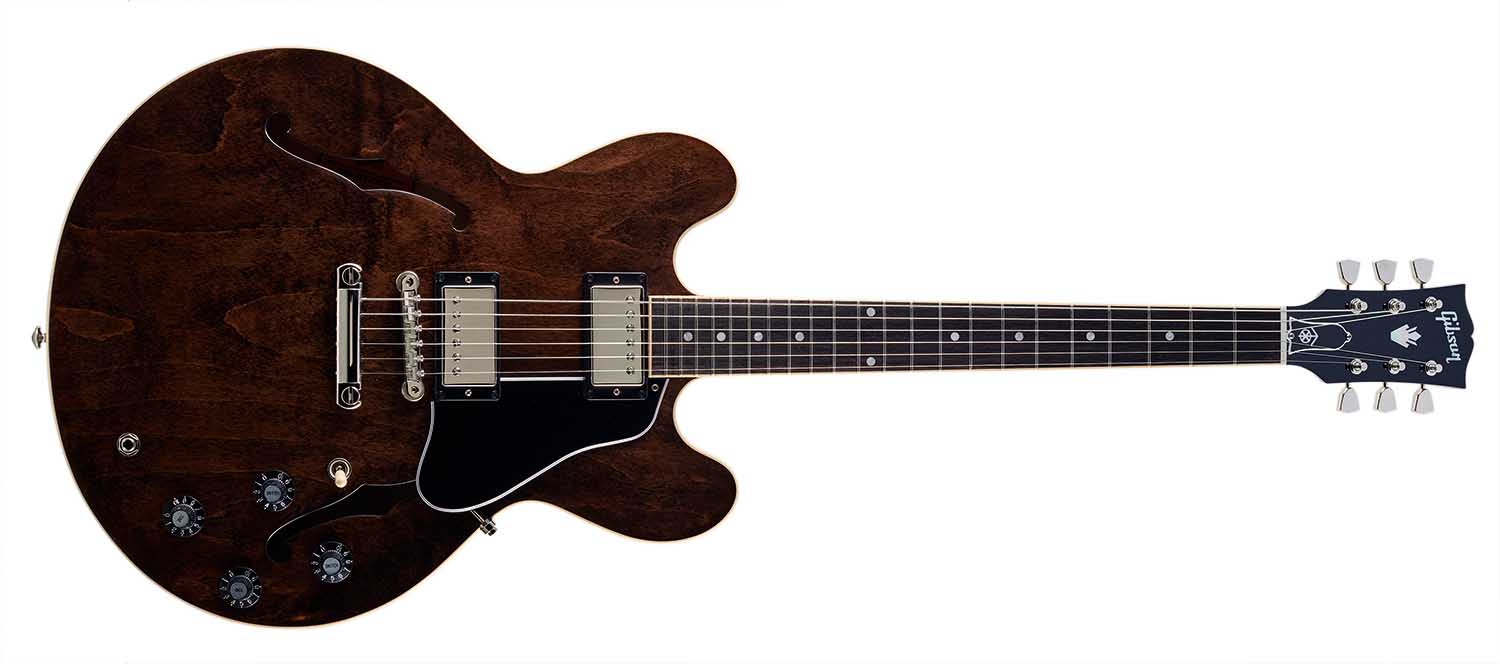Guitar World Verdict
A lightweight thinline that might have an artist association but has also a real working-player’s vibe. One of the best new ES-335s we’ve played in a while.
Pros
- +
A lightweight thinline.
- +
Huge versatility from the T-Type ’buckers.
Cons
- -
Only one finish and owls might not be your thing.
- -
The Original series ES-335 is cheaper.
You can trust Guitar World
Gibson’s Artist Collection currently holds some big-name thinlines such as the Chuck Berry ES-355, Trini Lopez and Slim Harpo ES-330.
But this release from a more contemporary artist – My Morning Jacket’s Jim James – outwardly nods back to Gibson’s Norlin-era models with its all over walnut finish, a common colour during the '70s, although it first appeared in the latter half of the '60s.
Now, the once-reviled '70s are cool again and this comes across as a workingman’s thinline, not forgetting the owl motifs on the headstock back and case – a cracking example powered by the new Gibson T-Type humbuckers, used across the current ES range.

“As the name implies, the T-Types are a tribute to the ‘T-Tops’ from the late '60s to the late '70s/early '80s,” says Jim De Cola, Gibson Brands’ R&D manager and master luthier. “We call them T-Types as we are using the same bobbins as our other historic pickups, which don’t have the ‘T’ embossed in the top, hence the term ‘T-Top’.
“They use 42-gauge poly wire and the same blueprint spec number of turns, as well as Alnico V magnets as the originals had. Both rhythm and lead pickups would share the same specs in regards to wire, turns and magnets, just as the originals had. The only difference would be cable lengths for rhythm and lead positions.
“The ES Models use a calibrated set of T-Types. The neck pickup is very slightly underwound and the bridge pickup is very slightly overwound – from the nominal T-Type spec – to provide a calibrated output. Otherwise, all the specs are the same.”

Unlike recent and heavier thinlines we’ve had on review, this sub-8lb ES-335 is perfectly weighted and it makes such a difference to the feel – and quite probably the sound, too.
All the latest guitar news, interviews, lessons, reviews, deals and more, direct to your inbox!
Jim has also spec’d the guitar with Gibson’s Slim Taper neck profile akin to the Les Paul ’60s Standard and Classic that (back to front) measures 20.5mm at the 1st fret and 23.7mm at the 12th, with quite full shoulders as opposed to ‘rounded C’ neck profile used on most other current ES models.
Comparing our reference Les Paul Classic with its retrofitted Burstbucker 1 and 2 humbuckers and, of course, its different construction, there’s a lot to like with these: slightly less hot and a more open midrange providing clarity at the neck, while the bright edge at the bridge is easily tamed with the tone control as you add in some gain.

Specs
- PRICE: $3,499 / £3,099 (inc case)
- ORIGIN: USA
- TYPE: Double-cutaway, semi-solid thinline electric
- BODY: Laminated maple/poplar/maple with f-holes and solid maple centre block
- NECK: Mahogany, slim taper profile, glued-in
- SCALE LENGTH: 624mm (24.57”)
- NUT/WIDTH: Graph Tech/43.5mm
- FINGERBOARD: Bound Indian rosewood, acrylic dot inlays, 305mm (12”) radius
- FRETS: 22, medium/jumbo
- HARDWARE: ABR-1 tune-o-matic bridge, lightweight aluminium stud tailpiece, Kluson Waffleback tuners – nickel-plated
- STRING SPACING, BRIDGE: 51.5mm
- ELECTRICS: Gibson T-Type calibrated covered humbuckers, 3-way toggle pickup selector, individual volume and tone controls for each pickup
- WEIGHT (kg/lb): 3.55/7.81
- OPTIONS: No
- RANGE OPTIONS: The Modern ES-335 Satin (£2,499) kicks off the current range; the Original ES-335 is £2,899. Other artist models include the Chuck Berry 1970s ES-355 (£6,099) and the Slim Harpo ‘Lovell’ ES-330 (£2,599)
- LEFT-HANDERS: No
- FINISH: Walnut (as reviewed) – gloss nitrocellulose
- CONTACT: Gibson

Dave Burrluck is one of the world’s most experienced guitar journalists, who started writing back in the '80s for International Musician and Recording World, co-founded The Guitar Magazine and has been the Gear Reviews Editor of Guitarist magazine for the past two decades. Along the way, Dave has been the sole author of The PRS Guitar Book and The Player's Guide to Guitar Maintenance as well as contributing to numerous other books on the electric guitar. Dave is an active gigging and recording musician and still finds time to make, repair and mod guitars, not least for Guitarist’s The Mod Squad.

